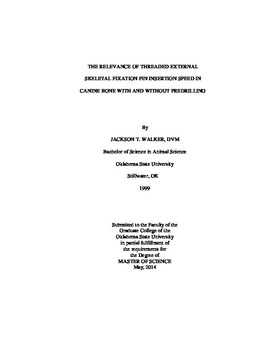| dc.contributor.advisor | Rochat, Mark C. | |
| dc.contributor.author | Walker, Jackson T. | |
| dc.date.accessioned | 2015-06-17T20:08:24Z | |
| dc.date.available | 2015-06-17T20:08:24Z | |
| dc.date.issued | 2014-05-01 | |
| dc.identifier.uri | https://hdl.handle.net/11244/15165 | |
| dc.description.abstract | External skeletal fixation is a useful tool for the veterinary surgeon in the management of various orthopedic conditions. Appropriate insertion of fixation pins is paramount to its successful application as premature pin loosening is the most common complication. Low speed insertion and predrilling have been recommended based on previous reports. Unlike predrilling, the true effect of insertion speed has been poorly evaluated. The effect of insertion speed (rpm) and pilot hole predrilling for placement of threaded external skeletal fixation pins on temperature and morphologic damage in cortical bone was evaluated. The null hypothesis states insertion speed and predrilling will have no significant effect on temperature and morphologic damage. Fixation pins were inserted into cadaveric canine femurs at speeds of 700rpm and 150rpm, with and without predrilling. Temperature was measured at each cortex 0.5mm and 3.0mm from each insertion site. Samples were examined grossly and by scanning electron microscopy and scored using visual analog scales for evidence of morphologic damage. Data were analyzed for maximum temperature, temperature increase, sites above thermal osteonecrosis thresholds, microcracks, thread quality and gross damage. Predrilling had a significant effect on maximum temperature, temperature increase, thermocouple sites exceeding osteonecrosis thresholds, microcracks, thread quality and gross damage. Speed of insertion had no significant effect on any of the measured parameters following predrilling but had a significant effect on thread quality without predrilling. Our results fail to reject the null hypothesis concerning insertion speed which has no significant effect on thermal damage and minimal effect on morphologic damage which is negated by predrilling. Our results reject the null hypothesis concerning predrilling and support the practice of predrilling fixation pin insertion sites. Linear advancement of the pin is a function of thread pitch and angular velocity. Previous reports have stated the importance of linear velocity being consistent with the angular velocity to avoid damage to the pin-bone interface. Based on those reports in combination with our findings, permitting the pin to advance at the appropriate linear velocity is more important than maintaining a low insertional rpm. | |
| dc.format | application/pdf | |
| dc.language | en_US | |
| dc.publisher | Oklahoma State University | |
| dc.rights | Copyright is held by the author who has granted the Oklahoma State University Library the non-exclusive right to share this material in its institutional repository. Contact Digital Library Services at lib-dls@okstate.edu or 405-744-9161 for the permission policy on the use, reproduction or distribution of this material. | |
| dc.title | Relevance of External Skeletal Fixation Pin Insertion Speed in Canine Bone with and Without Predrilling | |
| dc.type | text | |
| dc.contributor.committeeMember | Snider, Timothy A. | |
| dc.contributor.committeeMember | Gross, Marjorie E. | |
| osu.filename | Walker_okstate_0664M_13332.pdf | |
| osu.accesstype | Open Access | |
| dc.description.department | Veterinary Biomedical Sciences | |
| dc.type.genre | Thesis | |
| dc.subject.keywords | fixation pins | |
| dc.subject.keywords | insertion speed | |
| dc.subject.keywords | osteonecrosis | |
| dc.subject.keywords | predrill | |
